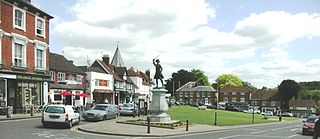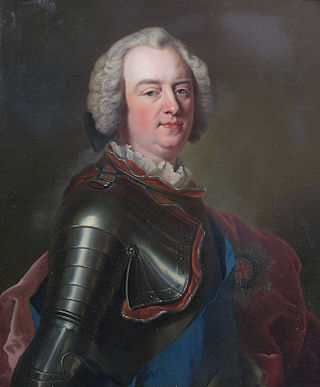Related Research Articles
An innings is one of the divisions of a cricket match during which one team takes its turn to bat. Innings also means the period in which an individual player bats. In cricket and rounders, "innings" is both singular and plural; this contrasts with baseball and softball in which the singular is "inning".

Westerham is a town and civil parish in the Sevenoaks District of Kent, England. It is located 3.4 miles east of Oxted and 6 miles west of Sevenoaks, adjacent to the Kent border with both Greater London and Surrey. It is recorded as early as the 9th century, and was mentioned in the Domesday Book in a Norman form, Oistreham. Hām is Old English for a village or homestead, and so Westerham means a westerly homestead. The River Darent flows through the town, and formerly powered three watermills.

The earliest definite reference to the sport of cricket is dated Monday, 17 January 1597. It is a deposition in the records of a legal case at Guildford, Surrey, regarding usage of a parcel of land. John Derrick, a coroner, testified that he had played cricket on the land when he was a boy in about 1550. Derrick's testimony is confirmation that the sport was being played by the middle of the 16th century, but its true origin is unknown. All that can be said with a fair degree of certainty is that its beginning was earlier than 1550, probably somewhere in south-east England within the counties of Kent, Sussex and Surrey. There have been suggestions that it can be traced to Flemish immigrants then resident in the area. The origin of the word cricket could derive from the Flemish word krick(-e), meaning a stick. Unlike other games with batsmen, bowlers and fielders, such as stoolball and rounders, cricket can only be played on relatively short grass, especially as the ball was delivered along the ground until the 1760s. Forest clearings and land where sheep had grazed would have been suitable places to play.
In the years from 1726 to 1750, cricket became an established sport in London and the south-eastern counties of England. In 1726, it was already a thriving sport in the south east and, though limited by the constraints of travel at the time, it was slowly gaining adherents in other parts of England, its growth accelerating with references being found in many counties. Having been essentially a rural pastime for well over a century, cricket became a focus for wealthy patrons and gamblers whose interests funded its growth throughout the 18th century.

In the 1772 English cricket season, it became normal practice to complete match scorecards and there are surviving examples from every subsequent season. Scorecards from 1772 have been found for three eleven-a-side matches in which the Hampshire county team played against an England team, and for one top-class single wicket match between Kent and Hampshire. The three Hampshire v England matches have been unofficially recognised by certain sources as first-class, although no such standard existed at the time. Prior to 1772, only four scorecards have survived, the last from a minor match in 1769.
Thomas Waymark was an English professional cricketer in the first half of the 18th century. He was probably born at or near to Mitcham in Surrey in June 1705. He is one of the earliest known players on record.
Edwin Stead was a noted patron of English cricket, particularly of Kent teams in the 1720s. He usually captained his teams but nothing is known about his ability as a player. He was born at Harrietsham in Kent and died in London.

Dartford Brent was an extensive area of common land on the outskirts of Dartford in Kent. Historically, it was the scene of a confrontation between King Henry VI and Richard Plantagenet, 3rd Duke of York in 1452 and in 1555 thousands of spectators were to witness the burning to death at the stake of Christopher Ward, a Dartford linen weaver, executed for his Protestant faith.

Hertfordshire County Cricket Club is one of twenty minor county clubs within the domestic cricket structure of England and Wales. It represents the historic county of Hertfordshire.
John Boorman was an English cricketer whose known career spanned 26 seasons from 1768 to 1793. In Scores & Biographies, Arthur Haygarth recorded that he found a reference to Boorman "in another account" which called him James, but Haygarth was convinced that the correct name was John which recurred. Haygarth discovered that Boorman was "probably" born at Cranbrook in Kent but may have resided for many years at Sevenoaks, though he certainly died at Ashurst in Sussex, where he spent his latter years as a farmer. Boorman's year of birth is an estimate based on evidence found by Haygarth that he was 53 when he died and Haygarth made a comment that Boorman "began playing in great matches very young". Boorman is believed to have been a left-handed batsman but it is not known if he bowled left arm. Like all bowlers of the time, he was underarm but his pace is unknown. As a fielder, he was generally deployed at point.
William Palmer was an English cricketer who played during the 1760s and 1770s. He was born and died in Coulsdon, Surrey. As a top-order batsman, he was a member of the local Coulsdon Cricket Club and also played county cricket for Surrey. Most of Palmer's career was before cricket's statistical record began in the 1772 season so relatively little is known of him. However, he regularly played in noteworthy matches until 1776. He has been recorded in 24 eleven-a-side matches and in one top-class single wicket match. He was last recorded playing for Coulsdon against Chertsey in 1784 when he was 47 years old.
A variety of Kent county cricket teams played matches from the early 18th century until the formation of the original county club in 1842. The county's links to cricket go back further with Kent and Sussex generally accepted as the birthplace of the sport. It is widely believed that cricket was first played by children living on the Weald in Saxon or Norman times. The world's earliest known organised match was held in Kent c.1611 and the county has always been at the forefront of cricket's development through the growth of village cricket in the 17th century to representative matches in the 18th. A Kent team took part in the earliest known inter-county match, which was played on Dartford Brent in 1709.
The 1745 English cricket season was the second season following the earliest known codification of the Laws of Cricket.
The 1748 English cricket season was the fifth season following the earliest known codification of the Laws of Cricket. Details have survived of six significant eleven-a-side and 18 single wicket matches. 1748 was the halcyon season of single wicket, perhaps never so popular before or since.
Charles Cumberland was an English cricketer of the late 18th and early 19th centuries who is known to have played in 26 matches which are retrospectively rated first-class.

Chislehurst Common is an open space in Chislehurst in the London Borough of Bromley in south-east London. It is jointly managed with St Paul's Cray Common.
Bourne Cricket Club was based at Bishopsbourne, near Canterbury in Kent, and played several major matches in the 18th century when it was one of the teams which effectively represented Kent as a county. Its home venue was Bourne Paddock. Bourne was patronised by Sir Horatio Mann, owner of the Bourne Park House estate, and was in reality his own private club. When Sir Horatio relocated to Dandelion, near Margate, the Bourne club ceased to exist.
Coxheath Common at Coxheath in Kent was used as a cricket venue for several known top-class matches between 1728 and 1789 as well as for a number of minor matches.
East Kent and West Kent were titles sometimes given to two cricket teams from their respective areas of the English county of Kent which generally played in matches prior to the foundation of the official Kent County Cricket Club in the mid 19th century. West Kent teams have been recorded from 1705, but there is no known record of an East Kent team until 1781. There were seven major matches from 1781 to 1790 in which teams of this type faced each other, although there is doubt about the match titles with sources using different team names.
The beginning of the 18th century saw sport acquire increasing importance in the lives of people in England and Ireland. Professionalism was by then established in the major gambling sports of bare-knuckle boxing, cricket and horse racing.
References
- ↑ Buckley GB (1935) Fresh Light on 18th Century Cricket , p. 4. Cotterell.
- ↑ Buckley, Op. cit., p. 56.
- ↑ Other matches played on Westerham Heath, Westerham, CricketArchive. Retrieved 2017-12-17.